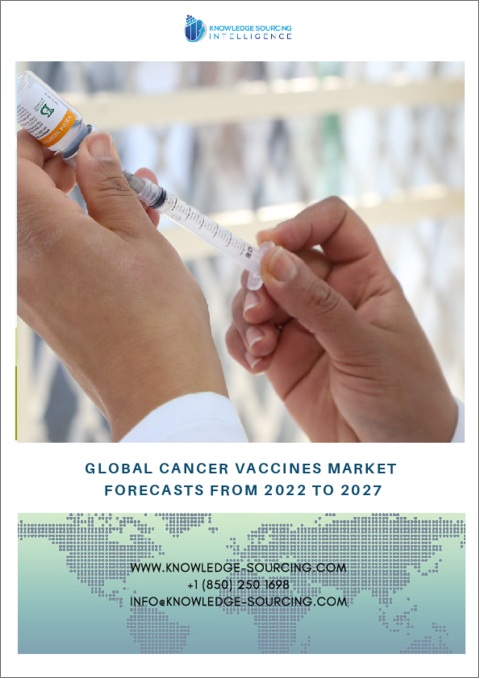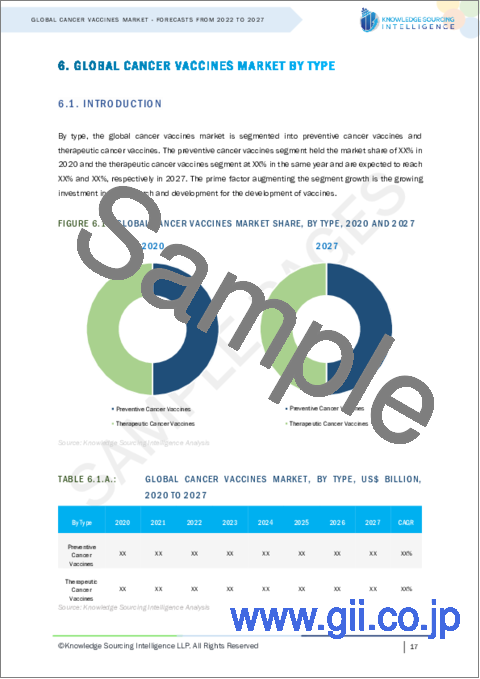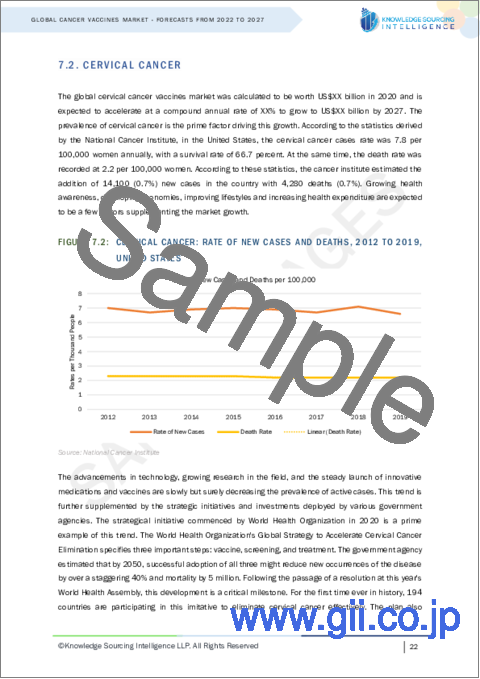|
|
市場調査レポート
商品コード
1086980
がんワクチンの世界市場予測(2022年~2027年)Global Cancer Vaccines Market - Forecasts from 2022 to 2027 |
||||||
|
● お客様のご希望に応じて、既存データの加工や未掲載情報(例:国別セグメント)の追加などの対応が可能です。 詳細はお問い合わせください。 |
|||||||
| がんワクチンの世界市場予測(2022年~2027年) |
|
出版日: 2022年04月08日
発行: Knowledge Sourcing Intelligence
ページ情報: 英文 135 Pages
納期: 即日から翌営業日
|
- 全表示
- 概要
- 目次
世界のがんワクチンの市場規模は、2020年の55億2,700万米ドルから、2027年には130億6,800万米ドルに達し、予測期間中のCAGRで13.08%の成長が予想されています。
当レポートでは、世界のがんワクチン市場を調査しており、市場の概要、市場の促進要因や抑制要因、技術・タイプ・用途・最終用途・地域別の分析、競合情勢、企業プロファイルなどを提供しています。
目次
第1章 イントロダクション
- 市場の定義
- 市場セグメンテーション
第2章 調査手法
- 調査データ
- 前提条件
第3章 エグゼクティブサマリー
- 調査のハイライト
第4章 市場力学
- 市場促進要因
- 市場抑制要因
- ポーターのファイブフォース分析
- 売り手の交渉力
- 買い手の交渉力
- 新規参入業者の脅威
- 代替品の脅威
- 業界における競合情勢
- 業界のバリューチェーン分析
第5章 世界のがんワクチン市場分析:技術別
- イントロダクション
- 樹状細胞がんワクチン
- 組換えがんワクチン
- 抗原/アジュバントがんワクチン
- 全細胞がんワクチン
- ウイルスベクター・DNAがんワクチン
- その他
第6章 世界のがんワクチン市場分析:タイプ別
- イントロダクション
- 予防型がんワクチン
- 治療型がんワクチン
第7章 世界のがんワクチン市場分析:用途別
- イントロダクション
- 子宮頸がん
- 前立腺がん
- その他
第8章 世界のがんワクチン市場分析:最終用途別
- イントロダクション
- 小児
- 成人
第9章 世界のがんワクチン市場分析:地域別
- イントロダクション
- 北米
- 米国合
- カナダ
- メキシコ
- 南米
- ブラジル
- アルゼンチン
- その他
- 欧州
- 英国
- ドイツ
- フランス
- その他
- 中東・アフリカ
- アラブ首長国連邦
- 南アフリカ
- イスラエル
- サウジアラビア
- その他
- アジア太平洋地域
- 中国
- 日本
- インド
- オーストラリア
- 台湾
- 韓国
- その他
第10章 競合環境と分析
- 主要企業と戦略分析
- 新興企業と市場の有利性
- 合併、買収、合意、およびコラボレーション
- ベンダー競争力マトリックス
第11章 企業プロファイル
- AstraZeneca plc
- GlaxoSmithKline plc.
- Merck & Co., Inc.
- Pfizer Inc.
- Moderna Inc.
- OSE Therapeutics
- Nouscom
- OncBioMune Pharmaceuticals Inc.
- Sanofi S.A.
- Bristol-Myers Squibb
The global cancer vaccine market is expected to grow at a compound annual growth rate of 13.08% over the forecast period to reach a market size of US$13.068 billion in 2027, from US$5.527 billion in 2020. Cancer vaccines are used to provide treatment or protection from cancer, which classifies them into prevention and treatment cancer vaccines. They are a type of immunotherapy that destroys cancer cells, stops the growth of tumors, and also helps in preventing any such cases in the body in the future.
Market Trend
The increased cases of cancer globally due to unhealthy living practises is one of the prime causes behind the growth of the cancer vaccine market. Also, the increasing research on inherited cancer and a definitive result in the field are expected to hold a large market for the growth of cancer vaccines. Cancer vaccines have been approved for Human Papilloma Virus (HPV) and Hepatitis B (HBV) by the FDA, which can provide significant growth to the market in the coming years.
Cancer vaccines are known for causing severe after-symptoms in the body, which may result in a constraint in the growth of the cancer vaccine market. Also, the increasing research for natural, plant-based, Ayurveda therapy for the treatment of cancer is expected to create some hurdles for the growth of the market in the future. The loss of immunity with age in the elderly population can also serve as a threat to the market's growth due to increased chances of low immune response after the vaccination. Besides that, the high price associated with cancer vaccines can also hamper their market growth.
Growth Factors
- Increasing cases of cancer worldwide:
The change in lifestyle habits, followed by the increasing consumption of unhealthy products like tobacco, cigarettes, and exposure to radiation and viruses, has been increasing the global number of cancer patients worldwide. According to the WHO, cancer is the leading cause of death worldwide and accounted for nearly 10 million deaths in 2020, which was higher than the 2018 data of 9.6 million deaths. Of these, lung cancer caused around 1.8 million deaths, cancer in the colon and rectum was responsible for 935,000 deaths, liver cancer caused 830,000 deaths, stomach cancer caused around 769,000 deaths, and breast cancer caused 685,000 deaths. The increasing rate of cancer mortality has put a major focus on the development of cancer vaccines.
- Family Cancer Syndromes:
Certain types of cancer seem to run in families, which can be due to the same exposure that increases cancer risk, like smoking and family running obesity, But, in some cases, like inherited cancer, an abnormal gene is passed along from one generation to another that can lead to cancer. According to the American Cancer Society, around 5%-10% of all cancers result directly from mutations. Increasing research and a definitive result in this field are expected to hold growth prospects for the development of cancer vaccines in the upcoming years.
Restraint
Increasingly Elderly Population: One of the major restraints on the cancer vaccine market is the growing elderly population, which is accompanied by low immunity in people. This is expected to serve as a constraint for the market's growth as a weak immune system hampers the immune response of the body and thus reduces the chances of an effective response by the cancer vaccines in the body. UN data, suggests that by 2050, around 1 in 6 people in the world will be over the age of 65, from 1 in 11 in 2019.
- The side effects associated with cancer vaccines can increase the demand for Ayurveda treatment:
Cancer Treatment Vaccines can cause various side effects, which depend on various factors like the type of cancer, how advanced it is the type of vaccine treatment, the dosage, etc. The National Cancer Institute has laid down a list of side effects like fatigue, headache, trouble breathing, weakness, chills, fever, low and high blood pressure, and certain allergic reactions as well. Also, Sipuleucel-T can trigger strokes in human bodies. Fear of such side effects, along with their severity, may hamper the growth of the cancer vaccine market.
This is expected to pave the way for Ayurveda and natural therapies in cancer treatment, which could pose a threat to the growth of the cancer vaccine market. Although there is no strict evidence or approval that Ayurveda as a system of medicine can treat cancer, researchers have found that yoga, meditation, and Ayurveda approaches are helpful as complementary therapies in cancer treatment. Besides that, the National Center for Biotechnology Institution that comes under the U.S. National Library of Medicine has laid down a list of certain plants like Flacourtia romantchi, Moringa oleifera, Ficus bengalensis, Semecarpus Anacardium, etc. that have scientific evidence of anticancer properties.
The COVID-19 Pandemic's Impact on the Cancer Vaccine Market: With the onset of the coronavirus, the prime motive of governments across the globe shifted towards controlling the spread of the COVID virus. This severely hampered the growth of the cancer vaccine, market as the healthcare units, pharmaceutical companies, and their research and development work shifted towards the development of COVIDvaccine and this created a major restraint for the growth of cancer vaccine development.
Market Segmentation:
- By Technology
Dendritic Cells (DC) Cancer Vaccines
Recombinant Cancer Vaccines
Antigen/Adjuvant Cancer Vaccines
Whole-Cell Cancer Vaccines
Viral VectoR&DNA Cancer Vaccines
Others
- By Type
Preventive Cancer Vaccines
Therapeutic Cancer Vaccines
- By Application
Cervical Cancer
Prostate Cancer
Others
- By End-Use
Pediatrics
Adults
- By Geography
North America
- USA
- Canada
- Mexico
South America
- Brazil
- Argentina
- Others
Europe
- U.K.
- Germany
- France
- Others
Middle East and Africa
- UAE
- South Africa
- Israel
- Saudi Arabia
- Others
Asia-Pacific
- China
- Japan
- India
- Australia
- Taiwan
- South Korea
- Others
TABLE OF CONTENTS
1. INTRODUCTION
- 1.1. Market Definition
- 1.2. Market Segmentation
2. RESEARCH METHODOLOGY
- 2.1. Research Data
- 2.2. Assumptions
3. EXECUTIVE SUMMARY
- 3.1. Research Highlights
4. MARKET DYNAMICS
- 4.1. Market Drivers
- 4.2. Market Restraints
- 4.3. Porter's Five Forces Analysis
- 4.3.1. Bargaining Power of Suppliers
- 4.3.2. Bargaining Power of Buyers
- 4.3.3. Threat of New Entrants
- 4.3.4. Threat of Substitutes
- 4.3.5. Competitive Rivalry in the Industry
- 4.4. Industry Value Chain Analysis
5. GLOBAL CANCER VACCINES MARKET ANALYSIS, BY TECHNOLGY
- 5.1. Introduction
- 5.2. Dendritic Cells (DC) Cancer Vaccines
- 5.3. Recombinant Cancer Vaccines
- 5.4. Antigen/Adjuvant Cancer Vaccines
- 5.5. Whole-Cell Cancer Vaccines
- 5.6. Viral Vector & DNA Cancer Vaccines
- 5.7. Others
6. GLOBAL CANCER VACCINES MARKET ANALYSIS, BY TYPE
- 6.1. Introduction
- 6.2. Preventive Cancer Vaccines
- 6.3. Therapeutic Cancer Vaccines
7. GLOBAL CANCER VACCINES MARKET ANALYSIS, BY APPLICATION
- 7.1. Introduction
- 7.2. Cervical Cancer
- 7.3. Prostate Cancer
- 7.4. Others
8. GLOBAL CANCER VACCINES MARKET ANALYSIS, BY END-USE
- 8.1. Introduction
- 8.2. Pediatrics
- 8.3. Adults
9. GLOBAL CANCER VACCINES MARKET ANALYSIS, BY GEOGRAPHY
- 9.1. Introduction
- 9.2. North America
- 9.2.1. USA
- 9.2.2. Canada
- 9.2.3. Mexico
- 9.3. South America
- 9.3.1. Brazil
- 9.3.2. Argentina
- 9.3.3. Others
- 9.4. Europe
- 9.4.1. U.K.
- 9.4.2. Germany
- 9.4.3. France
- 9.4.4. Others
- 9.5. Middle East and Africa
- 9.5.1. UAE
- 9.5.2. South Africa
- 9.5.3. Israel
- 9.5.4. Saudi Arabia
- 9.5.5. Others
- 9.6. Asia Pacific
- 9.6.1. China
- 9.6.2. Japan
- 9.6.3. India
- 9.6.4. Australia
- 9.6.5. Taiwan
- 9.6.6. South Korea
- 9.6.7. Others
10. COMPETITIVE ENVIRONMENT AND ANALYSIS
- 10.1. Major Players and Strategy Analysis
- 10.2. Emerging Players and Market Lucrativeness
- 10.3. Mergers, Acquisitions, Agreements, and Collaborations
- 10.4. Vendor Competitiveness Matrix
11. COMPANY PROFILES
- 11.1. AstraZeneca plc
- 11.2. GlaxoSmithKline plc.
- 11.3. Merck & Co., Inc.
- 11.4. Pfizer Inc.
- 11.5. Moderna Inc.
- 11.6. OSE Therapeutics
- 11.7. Nouscom
- 11.8. OncBioMune Pharmaceuticals Inc.
- 11.9. Sanofi S.A.
- 11.10. Bristol-Myers Squibb




